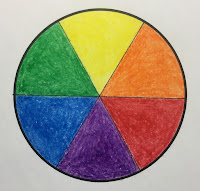What's missing? (5 of 8)
Perhaps you've noticed by now that two standard colors from our crayon box are missing on the color wheel: brown and black. That's because they are made up of more than one color.
Theoretically, black is a combination of equal parts blue, red, and yellow, (though in practice it's difficult to mix the black that most of us consider a "true" black.) Believe it or not, you can actually have a "warm" black (called "ivory black") and a "cool" black (called "lamp black"). "Ah!" you say- this explains why it's so frustrating, trying to match those black pants to your favorite black blouse... you thought "black is black". So, once again, it's handy to be able to evaluate whether a color is "warm" or "cool".
To understand brown, we have to go back to our basic color wheel, and talk about complementary colors:
Traditionally, complementary colors are the colors that appear across from each other on the color wheel: yellow and violet, orange and blue, red and green. Notice each pair has a color from the warm side and the cool side, and notice that each pair is a mixture of a primary and a secondary color. This means that when you mix complementary colors together, you have 50% of one primary color, and 25% of each of the other two colors making up the secondary color in the pair. These pairs produce different browns because they are a combination of all three primary colors in different percentages. For instance, mixing red and green, you get a brown that leans toward the reddish side, (because it's 50% red.)
Well, that explains all the various browns in the box, but will these other crayons find a home on the wheel?




.jpg)
Comments
Post a Comment